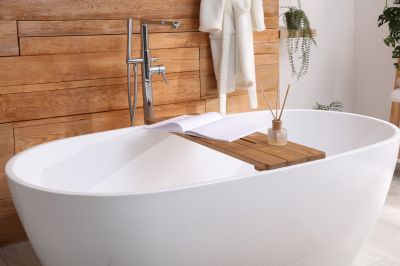Favorite Products For Efficient Bathtub Setup and Installation
Identify essential tools and accessories that help you install your bathtub quickly and without hassle.
 Installing a bathtub involves selecting the right products to ensure a safe, functional, and aesthetically pleasing setup. The process typically begins with choosing a suitable bathtub unit that fits the space and complements the bathroom design. Bathtubs come in various materials such as acrylic, cast iron, fiberglass, and composite, each offering different levels of durability, weight, and maintenance needs. Proper installation requires attention to plumbing connections, drainage, and waterproofing to prevent leaks and water damage.
Installing a bathtub involves selecting the right products to ensure a safe, functional, and aesthetically pleasing setup. The process typically begins with choosing a suitable bathtub unit that fits the space and complements the bathroom design. Bathtubs come in various materials such as acrylic, cast iron, fiberglass, and composite, each offering different levels of durability, weight, and maintenance needs. Proper installation requires attention to plumbing connections, drainage, and waterproofing to prevent leaks and water damage.
Top Overall Option
Acrylic Bathtub
Acrylic bathtubs are popular for their lightweight nature, ease of installation, and smooth, glossy finish. They are available in a variety of shapes and sizes to fit different bathroom layouts. Acrylic is also known for its good heat retention and ease of cleaning, making it a versatile choice for many homeowners. Properly installed acrylic tubs can provide durable and comfortable bathing experiences while maintaining an attractive appearance over time.
Types of Products For Bathtub Installations
Bathtub Units
Different materials and styles of bathtubs designed to fit various bathroom spaces and aesthetic preferences.
Faucet Fixtures
A range of faucet styles including deck-mounted, wall-mounted, and handheld options to complement the bathtub setup.
Drain Assemblies
Components that facilitate proper water drainage and prevent leaks, available in various finishes and configurations.
Overflow Covers
Protective covers that prevent water from overflowing and help maintain the integrity of the installation.
Sealing and Caulking Materials
Sealants used to waterproof joints and edges, essential for preventing water damage.
Support and Reinforcement Kits
Accessories that provide additional stability for the bathtub during and after installation.
Bathroom Wall Surrounds
Panels or tiles that surround the bathtub area, offering waterproofing and aesthetic options.
Accessibility Features
Grab bars, step stools, and walk-in doors designed to improve safety and accessibility.
Installation Tools
Specialized tools such as levelers, sealant guns, and plumbing wrenches to facilitate proper setup.
Waterproof Membranes
Materials used beneath the bathtub to prevent water seepage into surrounding structures.
Support Beams and Frames
Structural components that provide support for the bathtub, especially in custom or built-in installations.
Popular Choices
A common choice due to their lightweight design and ease of maintenance, available in many shapes and sizes.
Standalone units that add a stylish focal point to bathrooms with flexible placement options.
Designed to maximize space in smaller bathrooms, fitting neatly into corner areas.
Built into a custom surround or deck, offering a seamless integration with bathroom decor.
Designed to fit within three walls, ideal for standard bathtub alcoves.
Features jets for hydrotherapy and relaxation, often installed with specialized plumbing.
Vintage-style tubs with decorative feet, adding character to traditional bathroom designs.
Designed for accessibility, with doors that allow easy entry and exit.
Affordable options that are lightweight and easy to install, suitable for budget-conscious projects.
Heavy-duty and durable, offering excellent heat retention and a classic aesthetic.
Made from composite materials, providing seamless designs and versatile styling options.
Built into a platform or deck, allowing for customization and aesthetic flexibility.
Beyond the tub itself, accessories and installation components play a vital role in achieving a successful setup. Items such as faucet fixtures, drain assemblies, overflow covers, and sealing materials contribute to the overall functionality and longevity of the installation. Ensuring compatibility among these components can help streamline the installation process and reduce potential issues.
When planning a bathtub installation, it is also important to consider accessibility features if needed, such as grab bars or walk-in designs. These additions can enhance safety and convenience for users. Additionally, selecting high-quality installation tools and materials can facilitate a smoother process and improve the durability of the finished setup.
Whether remodeling a bathroom or building a new one, understanding the range of available products can help in making informed decisions. Consulting with professionals or researching product specifications can assist in selecting items that meet both aesthetic preferences and practical requirements. Proper planning and product choice are key to creating a functional and inviting bathroom space.
Key Buying Considerations
- Material durability and maintenance requirements
- Size and shape compatibility with bathroom layout
- Installation type (drop-in, alcove, freestanding, etc.)
- Plumbing and drainage compatibility
- Weight of the bathtub and support needs
- Accessibility features for safety and convenience
- Aesthetic style and finish options
- Water heating and heat retention capabilities
- Availability of matching fixtures and accessories
- Ease of cleaning and stain resistance
- Cost and budget constraints
- Warranty and manufacturer support
- Compatibility with existing bathroom plumbing
- Environmental factors such as noise and vibration during use
- Future resale value considerations
